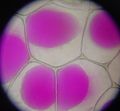Vacuole facts for kids
A vacuole is like a special storage bag inside a cell. Think of it as a tiny bubble surrounded by a thin wall called a membrane. Inside this bubble, cells can keep different things, like water, waste, or even helpful chemicals called enzymes. Vacuoles don't have a fixed shape or size; cells can change them as needed. They are found in many types of cells, but they are super important in plant and fungus cells.

(1) nucleolus
(2) nucleus
(3) ribosome
(4) vesicle
(5) rough endoplasmic reticulum (ER)
(6) Golgi apparatus
(7) Cytoskeleton
(8) smooth ER
(9) mitochondria
(10) vacuole
(11) cytoplasm
(12) lysosome
(13) centrioles
The liquid inside a vacuole is called cell sap. The jobs a vacuole does depend on the type of cell it's in. They are much more important in plant and fungus cells than in animal cells.
What Do Vacuoles Do?
Vacuoles have many important jobs for a cell. Here are some of them:
- They keep harmful substances away from the rest of the cell.
- They store waste products that the cell doesn't need.
- In plant cells, they hold a lot of water.
- They help keep the right pressure inside the cell. This pressure helps plants stand up straight.
- They help keep the cell's internal pH (how acidic it is) steady.
- They store small molecules that the cell might need later.
- They help get rid of things the cell no longer wants.
- In seeds, special vacuoles called 'protein bodies' store proteins. These proteins are used when the seed starts to grow.
Vacuoles are also important for a process called autophagy. This is how cells clean themselves by breaking down and recycling old or broken parts. They help get rid of damaged proteins that can build up in cells.
Some scientists think vacuoles help fight off tiny invaders like bacteria. Others believe certain vacuoles can even provide a home for helpful bacteria that live with the cell. In tiny living things called protists, vacuoles also store and help digest the food they eat.
Central Vacuole in Plants
Plant cells often have one very large vacuole called the central vacuole. It's usually the biggest part of a plant cell. This vacuole is surrounded by a membrane, and it stores water, nutrients, and waste materials.
The central vacuole is key for keeping the right pressure inside plant cells. This pressure, called turgor, helps the plant stay firm and upright. Without enough water in its central vacuoles, a plant will wilt.
Images for kids
See also
 In Spanish: Vacuola para niños
In Spanish: Vacuola para niños


